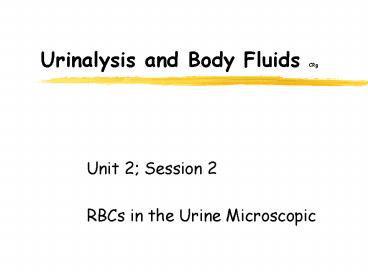Urinalysis and Body Fluids CRg - PowerPoint PPT Presentation
1 / 16
Title:
Urinalysis and Body Fluids CRg
Description:
Title: C H E M I S T R Y Subject: CHEMISTRY and BRANCHES Author: ASKEW Last modified by: Carolyn Ragland Created Date: 6/19/1996 11:38:00 AM Document presentation format – PowerPoint PPT presentation
Number of Views:135
Avg rating:3.0/5.0
Title: Urinalysis and Body Fluids CRg
1
Urinalysis and Body Fluids CRg
- Unit 2 Session 2
- RBCs in the Urine Microscopic
2
Microscopic Sediment Red Blood Cells
- Red blood cells
- Pathological finding - cannot appear in filtrate
if nephron is intact. - result of damage / injury to glomerular
membrane, or urinary tract (inc. renal calculi) - Isomorphic / fresh looking RBCs usually come from
lower tract - Dysmorphic / oddly shaped RBCs been subjected to
effects of urine environment longer.
Many RBCs and a squamous epithelial cell, low
power magnification / lpf
3
Microscopic Sediment Red Blood Cells
- differentiate
- Hemoglobinuria free hemoglobin in urine
- Hematuria presence of increased numbers of
intact RBCs in urine - Hemosiderin orange/ brown pigment found as
intracellular granules
4
Microscopic Sediment Red Blood Cells
- Red Blood Cells
- Although NV 0-2 hpf, an occasional RBC is more
significant than occasional WBC. - American Urological Association
- defines clinical significant microscopic
hematuria as three or more RBC / hpf in 2 of 3
properly collected urine samples.
5
Microscopic Sediment Red Blood Cells
- Red Blood Cells
- NV 0-2 / hpf
6
Microscopic Sediment Red Blood Cells
- Red Blood Cells
- Detection
- High power magnification
- Reduced light
- yellow - red sheen (sometimes blue-green)
- Usually highly retractile,
- Use fine adjustment knob
- In dilute or alkaline urine appear as ghost or
shadow cells - Can be any shape
- Normal disc
- Dysmorphic
- swollen or
- crenated .
7
Microscopic Sediment Red Blood Cells
- RBCs of various shapes different levels of
magnification
8
Microscopic Sediment Red Blood Cells
- RBC can even get small blebs on them, making
them appear similar to budding yeast.
9
Microscopic Sediment Red Blood Cells
- Red Blood Cells
- Urine RBCs can be easily confused with
- WBCs
- Generally larger
- Contain nucleus
- Do not lyse in 2 acetic acid
10
Microscopic Sediment Red Blood Cells
- Red Blood Cells
- Urine RBCs can be easily confused with
- Yeast
- Generally refract light differently
- Usually have buds / and often are more egg
shaped - Sometimes demonstrate branching
- Do not dissolve in 2 acetic acid
- Do not stain with eosin
11
Microscopic Sediment Red Blood Cells
- Red Blood Cells
- Urine RBCs can be easily confused with
- Bubbles or oil droplets
- Large variation in size. Even more refractive /
and have hard appearing edges. - Confirmation? test for hemoglobin - by dipstick,
which is most sensitive to free hemoglobin,
rather than intact RBCs
12
Microscopic Sediment Red Blood Cells
- RBC or yeast cell?
13
Microscopic Sediment Red Blood Cells
- RBC or yeast cell?
14
Microscopic Sediment Red Blood Cells
- yeast
15
RBCs (contd)
Air Bubble
Oil Droplets
16
Microscopic Sediment Red Blood Cells
- Viewed on high dry 0-2 /hpf
- Damage anywhere in the urinary tract
- No nuclei Yellow-greenish biconcave /
hourglass - if on edge - Swollen or Ghosts if in hypotonic or alkaline
urine - Crenated if in hypertonic urine
- Can be confused with
- WBCs
- Yeast
- Oil dropplets
- Air bubbles































